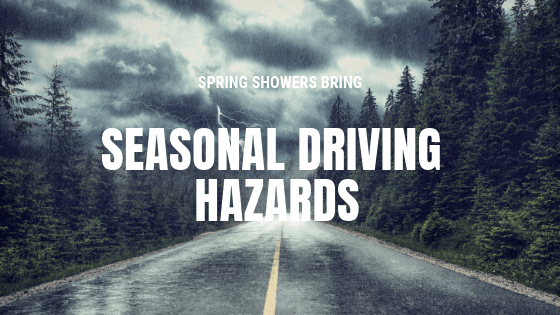Spring Showers Bring Seasonal Driving Hazards
Spring is nearly here, and with it comes sunshine, pollen, and, you guessed it, new driving hazards. With the disappearance of snow and ice, you’d think it would mean safe driving – but that isn’t always the case.
Follow along to learn about spring driving hazards, and take a peek at our Spring Safety Checklist, aimed at keeping you safely on the road.
Rain, Rain, Go Away
According to the Federal Highway Administration, rain was a culprit of 46 percent of all weather-related crashes from 2005 to 2014, and wet pavement in general accounted for 73 percent.
What makes rain and wet pavement so dangerous? For one, slippery roads reduce your truck‘s handling and increase the distance it takes to stop (up to 4 times normal stopping distance). Big puddles can also cut down on tire traction and could lead to hydroplaning. Remember you can hydroplane at speeds as low as 35 mph.
Winter Wear and Tear
It’s no secret, winter weather wreaks havoc on the roads. Snow plows, salt, sand, and the aftermath of ice can all leave roads a bit battered. Once snow melts away, expect to drive over new potholes. Not only does that grime affect the roadways, think of what it could be doing to your rig! A little spring maintenance can go a long way in reducing mechanical risks.
Animal activity
Animals are incredibly active during the spring. Some are emerging from hibernation, and others are entering mating season. This could mean that more animals are crossing streets and roaming around. Many animals, especially deer, are most active at dawn or dusk. As harsh as this sounds, remember not to swerve out of the way of squirrels and birds, especially at high speeds, you risk injuring others on the road around you.
Share the Road
Animals aren’t the only thing coming out of hibernation. Bicyclists, too make appearances in vast numbers in the spring. Driving alongside a cyclist can make driving maneuvers more treacherous.
Spring Safety Checklist
- Check your lights: Since spring rain hinders driving visibility, make sure all your lights work, and if they’re dimmer than they should be, consider replacing or buffing them to ensure they shine brightly.
- Replace your wiper blades: Worn-out wiper blades may not be up to the task of clearing water away from your windshield. Check your wiper blades and replace them if necessary (usually once a year). You can do this yourself, or pop over to any auto-parts store for help.
- Check your tire pressure: Harsh winter weather can deflate your tires. Make sure you have enough air in them once spring rolls around. We suggest making it a habit and check them at the beginning of every season. (As a bonus, proper tire pressure can also help you increase your mpg. Score!)
- Slow down and drive carefully: The first few rainy days of spring can produce exceptionally slippery roads due to oil and other leaked fluids mixing with rainwater, so slow down and increase your stopping distance when it’s raining.
- Keep your eyes peeled for bad road conditions: Remember that harsh winter weather breeds potholes and other driving obstacles. That doesn’t give you free license to swerve willy-nilly! Driving a truck is a big responsibility, you still have to look out for other drivers around you.
- Watch out for animals: This is especially important during the early morning and evening when animals are most active.
Don’t forget that tickets don’t have a season. Have a ticket? Join ORDP and welcome to the future of CDL protection. We’re built on simplicity because life’s crazy enough without worrying about tickets.
Drive safely!


Recent Comments